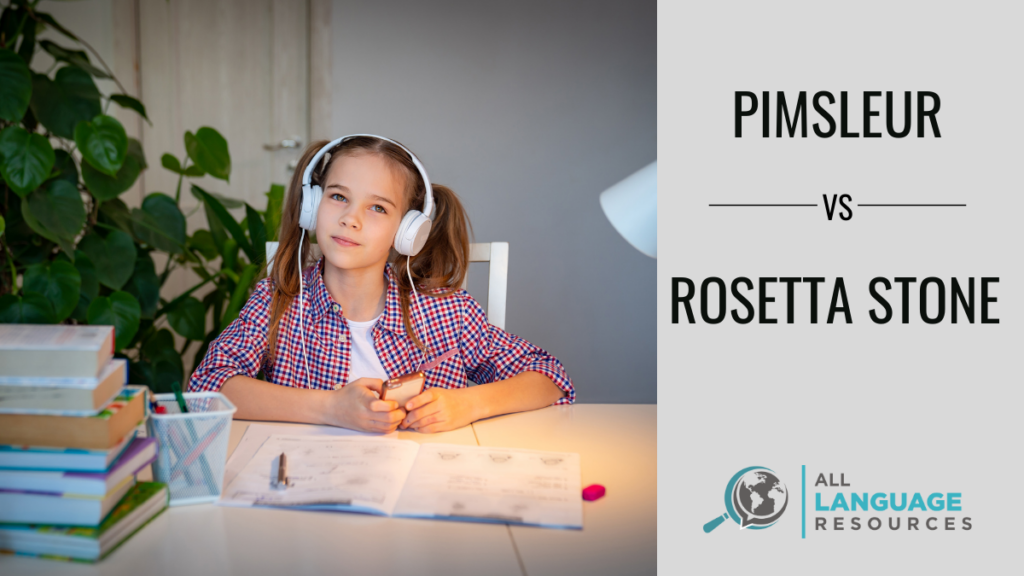If you’ve started looking for a language learning course, chances are that you’ve already come across both Pimsleur and Rosetta Stone. Which one is better?
Perhaps because of how famous both companies are, they used to be some of the most absurdly expensive courses around. Pimsleur still sells CD versions of its courses for hundreds of dollars – far more expensive than other more modern products.
The high cost of the program made it difficult to recommend. But luckily, Pimsleur and Rosetta Stone have finally entered the modern world. Both companies have added a subscription option which lowers the cost significantly. Plus, you won’t have to use CDs anymore – they’ve created decent apps.
Table of Contents
Out of the two apps, Pimsleur offers a much more comprehensive language learning program.
That doesn’t necessarily mean that Pimsleur should be your choice. There are lots of good courses from both big-name companies and smaller content creators that you may have never heard of. Check out the sidebar/menu to find our most recommended resources in the language you’re studying.
Before we begin: if you’d prefer, you can jump right into the individual reviews of Pimsleur and Rosetta Stone.
Rosetta Stone Review
Pimsleur Review
How are Rosetta Stone and Pimsleur similar?
Aside from being two of the most well-known names in language learning, there’s a lot that Rosetta Stone and Pimsleur have in common.
Lots of languages
Both companies offer courses in lots of different languages. Rosetta Stone teaches 25 languages, and Pimsleur has over 50 languages to choose from.
There’s a good chance that Rosetta Stone teaches the language you’re learning, but if it doesn’t, Pimsleur’s even more likely to cover it.
Beginner to Intermediate(ish) levels
Both courses finish somewhere around the intermediate level. They each have a different teaching approach, so you’ll end up with different strengths and weaknesses in your language skills.
In any case, if you’re already to the intermediate level, you probably won’t get much out of either course.
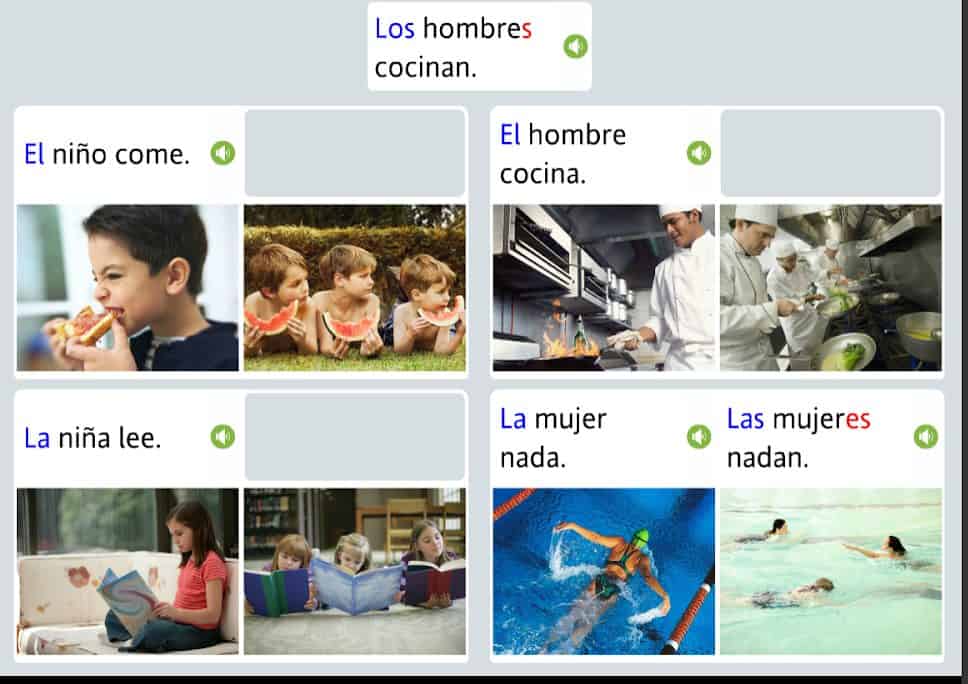
Lessons are structured well
Both companies have done a good job of designing the content in their courses — the structure of their lessons makes sense. Concepts build on each other logically, and there are lots of opportunities to review what you’ve learned.
In this way, they do better than most other resources in guiding your learning. But, they do both still have gaps that you’ll probably want to fill in with other resources.
Grammar is mostly ignored
Both Pimsleur and Rosetta Stone don’t touch on grammar much. For Rosetta Stone, it’s pretty much impossible to explain grammar because everything is taught in the language you’re learning, by matching words with pictures.
The people at Pimsleur have simply decided that teaching other things is more important.
For a beginner, it’s probably fine to not spend much time worrying about grammar. But, as you reach higher levels, putting real effort into working on grammar can pay dividends.
Repetitive
Both companies teach languages in a repetitive manner. The lessons are very similar across all levels, and you’ll almost certainly find yourself bored at some point.
This is especially true for Rosetta Stone. The constant dragging and dropping of pictures and captions could make it unbearable to study this way long-term.
Although Pimsleur could also get boring, its lessons force you to actively engage and speak out loud regularly. The fact that the lessons have lots of speaking makes the repetition more bearable. Plus, you’re not simply repeating, you have to form your own sentences.
How do Pimsleur and Rosetta Stone differ?
Although there are quite a few similarities between the two products, the differences are what I find most interesting. Despite the fact that they’re both famous language-learning companies, the manner in which they teach is quite different.
No English vs Having Translations
Perhaps the biggest difference in the lessons is how English is used. Rosetta Stone uses an immersion approach. This means that it completely removes English from the lessons. Instead, everything is taught with pictures and your target language.
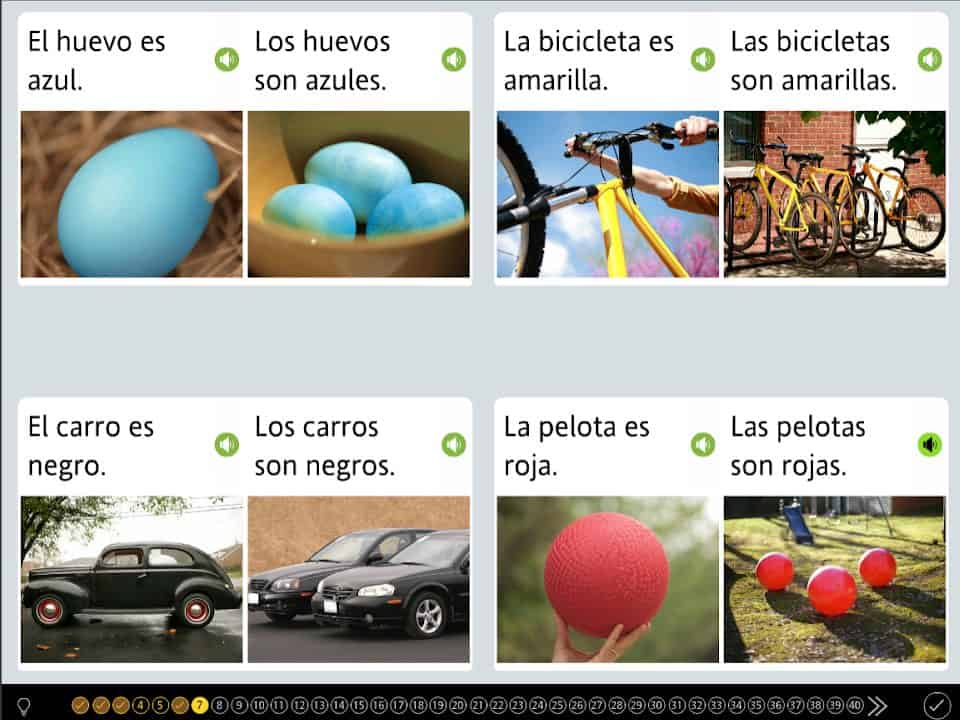
Pimsleur, on the other hand, has lots of translations and uses English to prompt you to say different things throughout the lessons.
The immersion approach in Rosetta Stone can help you learn basic vocabulary, but you will struggle to understand sentence structure or more complex concepts. Using pictures works great for simple things (like ‘dog’) but it’s less clear for more abstract ideas (like ‘decision’ or ‘hope’).
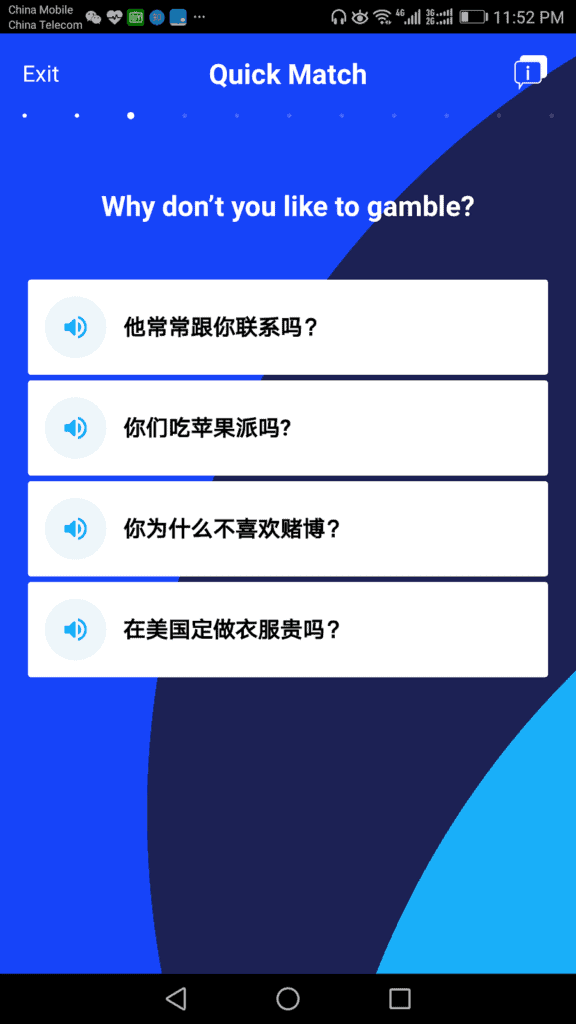
Visual vs Auditory Lessons
Since Rosetta Stone doesn’t include any translations, it should be no surprise that they depend on visual cues to teach the language. A lot of the exercises involve matching pictures to words.
Because of the nature of the lessons, the written language is also more prominent with Rosetta Stone.
That doesn’t mean that Rosetta Stone won’t help you with your speaking or listening skills. They have plenty of exercises and speech recognition software (though it’s not that good). But, when compared with Pimsleur’s lesson style, the oral language isn’t emphasized as heavily.
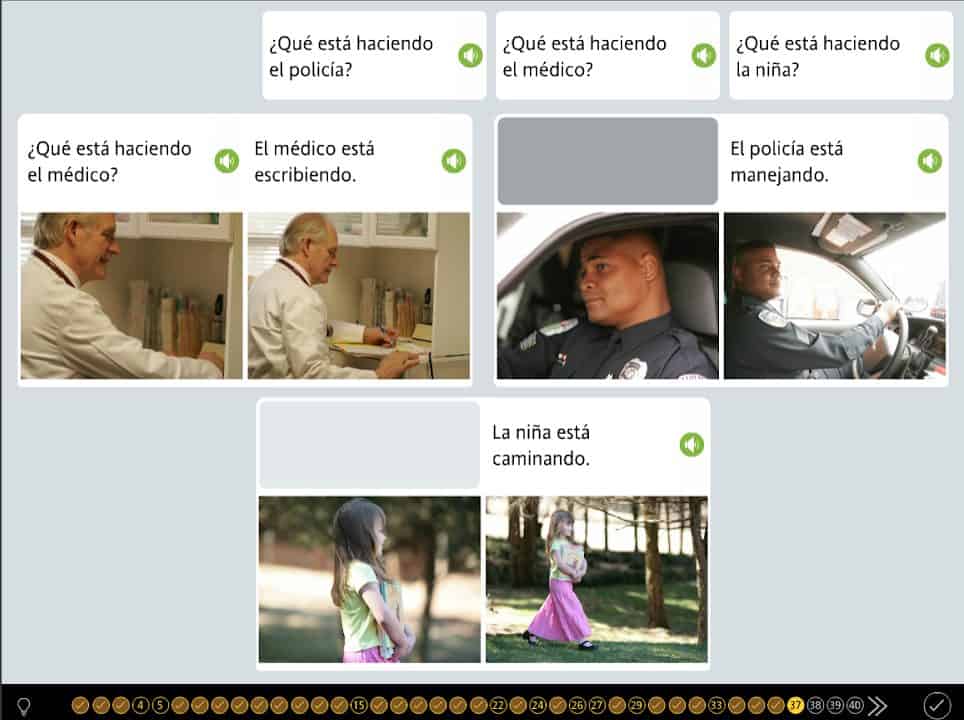
With Pimsleur, lessons focus almost entirely on the aural and verbal components of language learning — speaking and listening. And while there are some exercises that require reading, they’re clearly more of an afterthought.
Pimsleur teaches using audio lessons. You’ll listen to the host, repeat, and be prompted to put together sentences with words you’ve already learned. The lesson style forces you to actively participate throughout, meaning you’ll have to use what you’ve learned and actually speak the language.
For someone who would like to study while commuting to work or while doing anything else where audio courses are ideal, Pimsleur would be a much better choice.
Pimsleur also provides a more effective route to learning a language overall. It is much better for learning about the culture of your target language. Most companies that offer courses for lots of different languages struggle to include the unique cultural aspects of each language.
Aside from a handful of videos for some languages, Rosetta Stone basically ignores culture completely. The lessons feel very formulaic. The words they teach and images they use seem like they’re probably the exact same for every language.
While it may not always be necessary to learn about the culture of a language you’re learning, doing so will make things a lot more fun and help you stay motivated.
Pimsleur does much better with this. While most of the lessons could be very similar for every language, they also have some parts that are related to the culture of the language you’re learning.
For example, the Pimsleur Mandarin course mentions lots of different Chinese cities and landmarks throughout the lessons.
Additionally, in their app, most lessons also include a written description of some unique aspect of the culture. Since there were 150 lessons in the Mandarin course, this ended up being a ton of interesting cultural information.
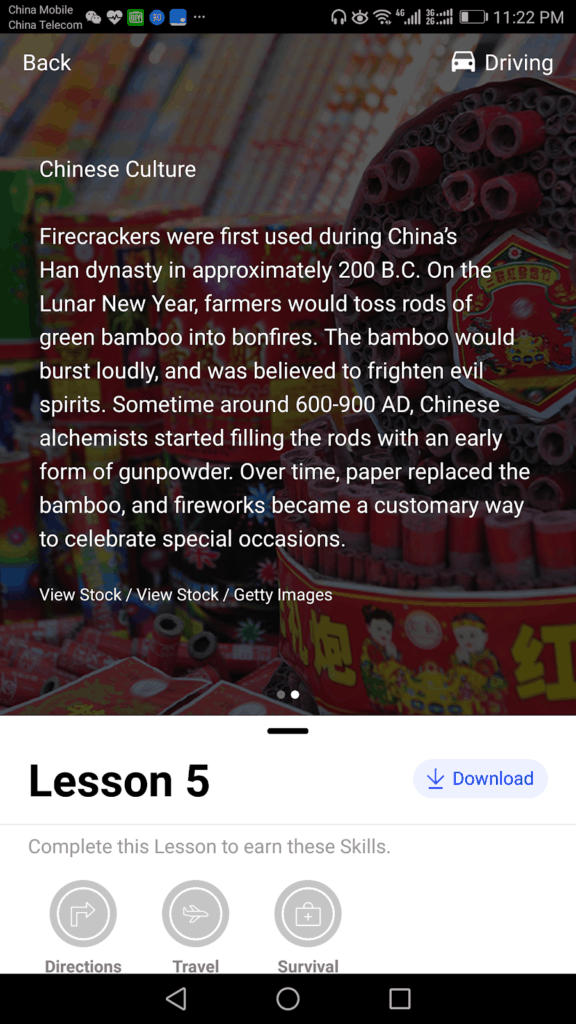
Comparing the Costs
Rosetta Stone offers subscriptions of three or 12 months, as well as a lifetime option. The price per month is $11.99/month for three months (one language) and $7.99/month for one year. The lifetime subscription is $179 and grants access to all Rosetta Stone language courses.
Pimsleur offers two subscription prices, depending on the language — one is $14.95/mo and the other is $19.95/mo. For $20.95/month, you can gain an all-access pass to all languages offered.
Pimsleur has a free 7-day trial and Rosetta Stone has a 30-day money-back guarantee if you decide to cancel.
How to Use Pimsleur as Part of a Language Learning Program
Pimsleur offers a lot to a beginning language learner, especially because it features courses in so many different languages! Check out these tips to get ideas about how to use Pimsleur most effectively.
- One of the best additional resources to pair with your Pimsleur course is something or someone to help you master grammar. Pimsleur emphasizes conversational language, which is great for someone who wants to spend a few months preparing to travel abroad. But you will want a solid foundation in the rules of the language later on to gain true fluency. If you learn well from text, try purchasing a used college textbook. This will break down concepts like verb conjugations and offer activities and drills, too. If you learn better in person, you may want to save up for a few lessons with a qualified tutor. The tutor can explain grammar rules and offer examples of how to use them. Apps like Italki can connect you to certified tutors around the world, and allow you to select the hourly rate you can afford.
- While Pimsleur does offer some grammar instruction, it does not focus on it. The benefit of this is that a beginner does not get bogged down in complex issues, and can instead focus on learning core vocabulary and quickly getting conversational. That said, Pimsleur’s listen-and-repeat model to learn conversational language only works if you do what the narrator says, and genuinely speak the words and phrases out loud. If you’re walking and listening to the lesson on your earbuds, randomly saying “Hello, how are you today?” in German or Tagalog may seem embarrassing. But the more you practice speaking aloud, the more quickly your mouth learns to shape new sounds, and you will get over the inevitable self-conscious feeling of trying something new.
- One of the potential weaknesses in Pimsleur’s program is that it has a heavy audio focus, which might not work well if you learn best visually. It does offer some lessons on reading especially in languages that use a non-Roman alphabet. But for a visual learner, you may want to pair Pimsleur with Rosetta Stone or seek out free image-heavy enrichment activities like watching movies in your target language.
- If you thrive on person-to-person interaction, you will probably enjoy the listen-and-repeat structure of Pimsleur lessons, but you may also need some peer-to-peer interaction. If you want to test out the phrases you learn in Pimsleur in some real-life conversation, try downloading a free app like HelloTalk. HelloTalk works kind of like a dating app to connect you with potential conversation partners around the world. The great thing about this is that you will enter a safe zone where everyone appreciates that you are still learning your target language, and will not judge you for any mistakes!
- Finally, keep in mind that how much you get out of a Pimsleur course is ultimately up to you. If you commit to doing at least one lesson a day, keep up with review activities, and perform the spoken portions of each lesson, you will learn much more than someone who does a handful of lessons once a month. That said, it is also true that adding enrichment activities to any core language learning program will help you learn faster. Holding a conversation in the HelloTalk app once a week on top of daily Pimsleur activities will speed along your conversational ability, for example. Watching TV shows in your target language every night will build your listening comprehension more quickly than just depending on the listening activities in Pimsleur. Basically, the more time you commit to learning a new language, the faster you will learn it!
How to Use Rosetta Stone as Part of a Language Learning Program
Rosetta Stone does not make the best choice for a core language-learning program for most people because of its immersive, no-English model. But it can make a good auxiliary resource for a visual learner. It can also help a beginner quickly learn a set of core vocabulary around useful topics like travel and family.
Check out these tips to learn how to make the most of your Rosetta Stone experience.
- Just like with Pimsleur, you will do best with Rosetta Stone if you set aside regular study time every day to complete lessons. Each Rosetta Stone lesson builds on the knowledge you gained in previous lessons, so if you go weeks or months between lessons, you will forget key things you need to know and likely need to complete previous lessons over again.
- Rosetta Stone emphasizes your brain’s innate ability to connect images and words. This can work well, especially to help you master core vocabulary. But it often falls flat when you need to learn how to put words together into sentences in languages that don’t use the same grammar patterns as English. In this case, you should explore additional resources or even another learning program that focuses more heavily on grammar. Babbel provides more activities focused on grammar, for example.
- Likewise, if your target language uses a different script or alphabet, you may want to find an online resource to help you master it instead of counting on “picking it up” as you go without any English explanations in Rosetta Stone.
- One of the great things about Rosetta Stone is that it has speaking activities you have to complete to pass a lesson or finish a unit. The program contains direct speaking software to grade your pronunciation. While no software works perfectly to help you gain a natural accent, being forced to speak your target language out loud really does help! Don’t wimp out and skip the speaking activities. Many languages contain sounds not used in English, and your mouth has to learn how to shape those new sounds! Plus, saying new words out loud helps cement them in your memory.
- Finally and perhaps most importantly, most learners will not do well solely using Rosetta Stone. Pair this program with additional reading writing, listening, and speaking tools to give you a well-rounded foundation in your new language. In fact, you will probably gain fluency much faster if you can transform your life outside of your dedicated study time into a more immersive langauge-learning environment, too. For example, swap out your regular evening Netflix session for an hour watching a movie in your target language.
Alternatives to Pimsleur and Rosetta Stone
Babbel
Babbel offers a lesson and drill-heavy intro to many languages. It is a little bit gamified like the popular free app Duolingo. It lacks the conversation-heavy approach of Pimsleur, but it does give you a better overall understanding of a new language. It does a good job explaining basic grammar, for example.
If you really want to gain fluency in a new language, Babbel offers much more than Rosetta Stone. If you want to quickly get conversational, Pimsleur might deliver what you need more quickly than Babbel.
Babbel has a subscription-based model just like both Rosetta Stone and Pimsleur. It costs a little less than both programs. The only big downside of Babbel compared to Rosetta Stone and Pimsleur is that Babbel currently only offers 14 languages.
Storylearning
If you hate the classroom feel of a traditional language learning program or wince at the call-and-response style of Pimsleur’s constant spoken repetition, you may need a more unique and engaging learning program like Storylearning.
Storylearning plunges you into an adventurous story right at the beginning of the course. You get a brief chapter of the story to keep you hooked at the beginning of each new section of the course. Because you will naturally want to know what happens next you will find the activities and drills built into the story quite interesting.
Storylearning is an online course, not an app. It has a one-time cost instead of a subscription. Its only other downside is that it does not offer any direct speaking software like Rosetta Stone and Pimlsier do.
OuiNo
OuiNo uses a super individualized approach to language learning. You have the option to take lessons on topics that interest you and tailor your study to your individual level.
One of the great things about this program is that it is specifically designed to work as the core of your study, but not the whole of it. Ouino will cover key areas such as reading, writing, listening, and speaking. But it also encourages you to seek out real-life experiences and other resources to enrich your language-learning experience.
The big downside to this newer program right now is that it only offers five European languages. You will need to look to a more developed program like Pimsleur to find a course in a language such as Tagalog or Arabic.
Recommendations
If you had to choose between Pimsleur and Rosetta Stone, Pimsleur is easily the better option.
Rosetta Stone may work for beginning learners with a strong preference for visual content and a distaste for learning aurally, but that’s about it.
Still, in the real world, the choice isn’t between Pimsleur or Rosetta Stone — there are plenty of other good courses that should be considered.
To see all of our favorite programs, online subscriptions, apps, podcasts, and YouTubes for the language you’re learning, look for your language in the table below.
Most Recommend Resources By Language
Final Thoughts
If you find yourself hesitating between subscribing to the Rosetta Stone or Pimsleur app, remember that Rosetta Stone offers a visually appealing program with no English lessons. Pimsleur offers a more accessible and comprehensive language-learning program.
Pimsleur is a good option that will get you speaking much faster than almost any other course. It isn’t perfect by any means, but for $15-$20/mo, it’s a solid choice.
Rosetta Stone, while it has improved a lot, is just not that great. It’s still more expensive than most competitors without offering anything particularly unique. In fact, it’s quite a bit worse than other cheaper courses.
So, the winner is pretty clearly Pimsleur. If you’d like to read a bit more about exactly what it’s like to use either of these products, read the in-depth reviews of each.

